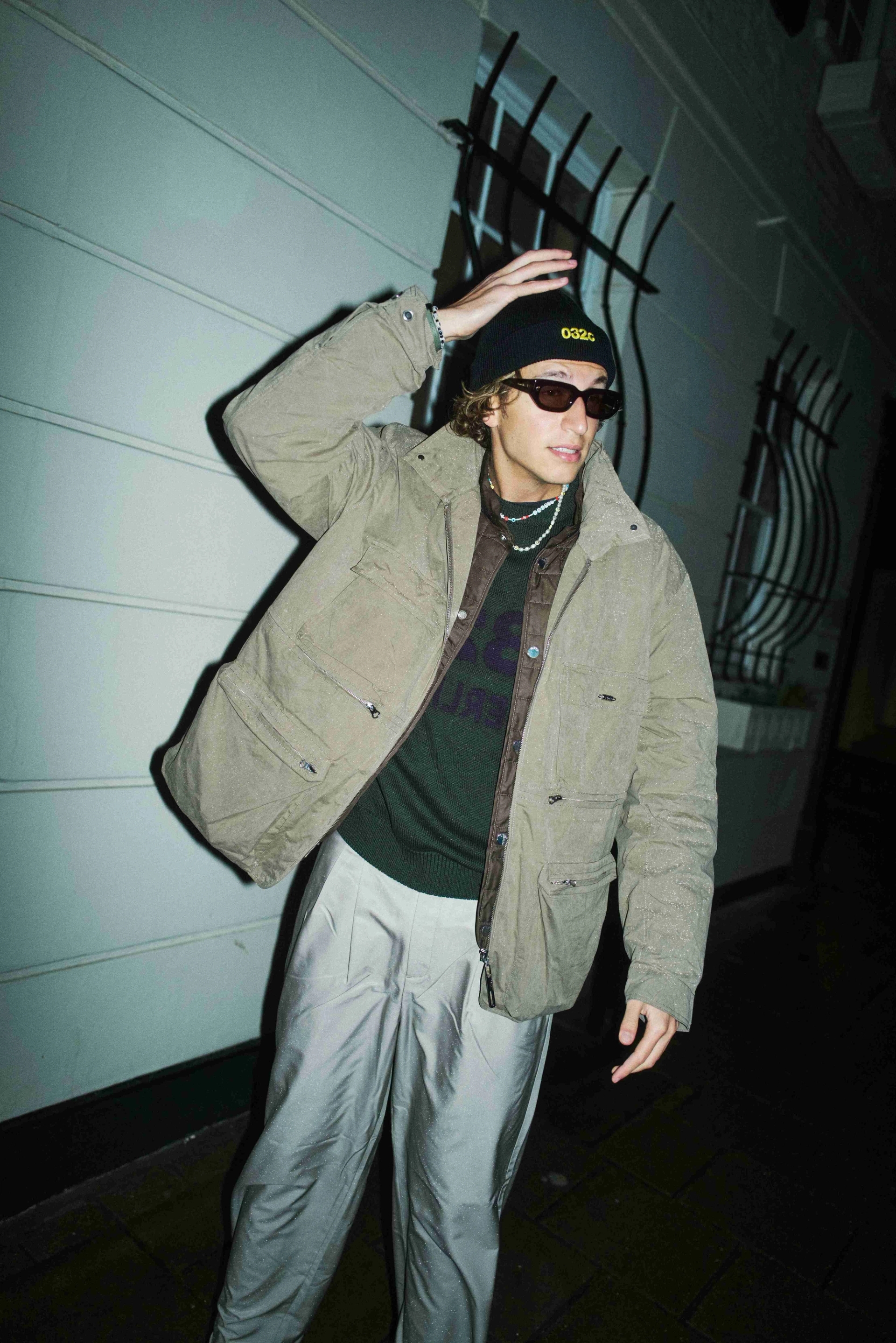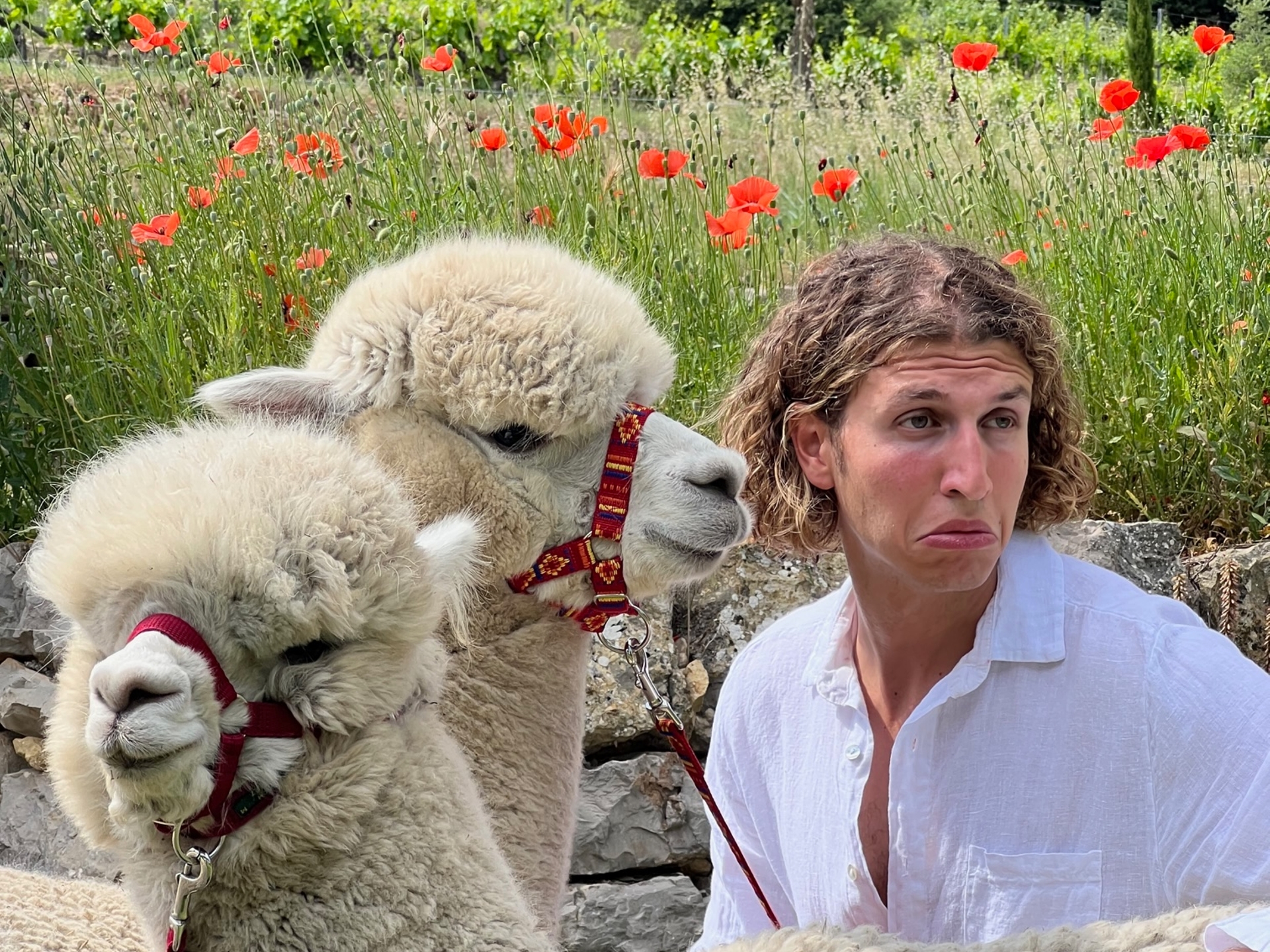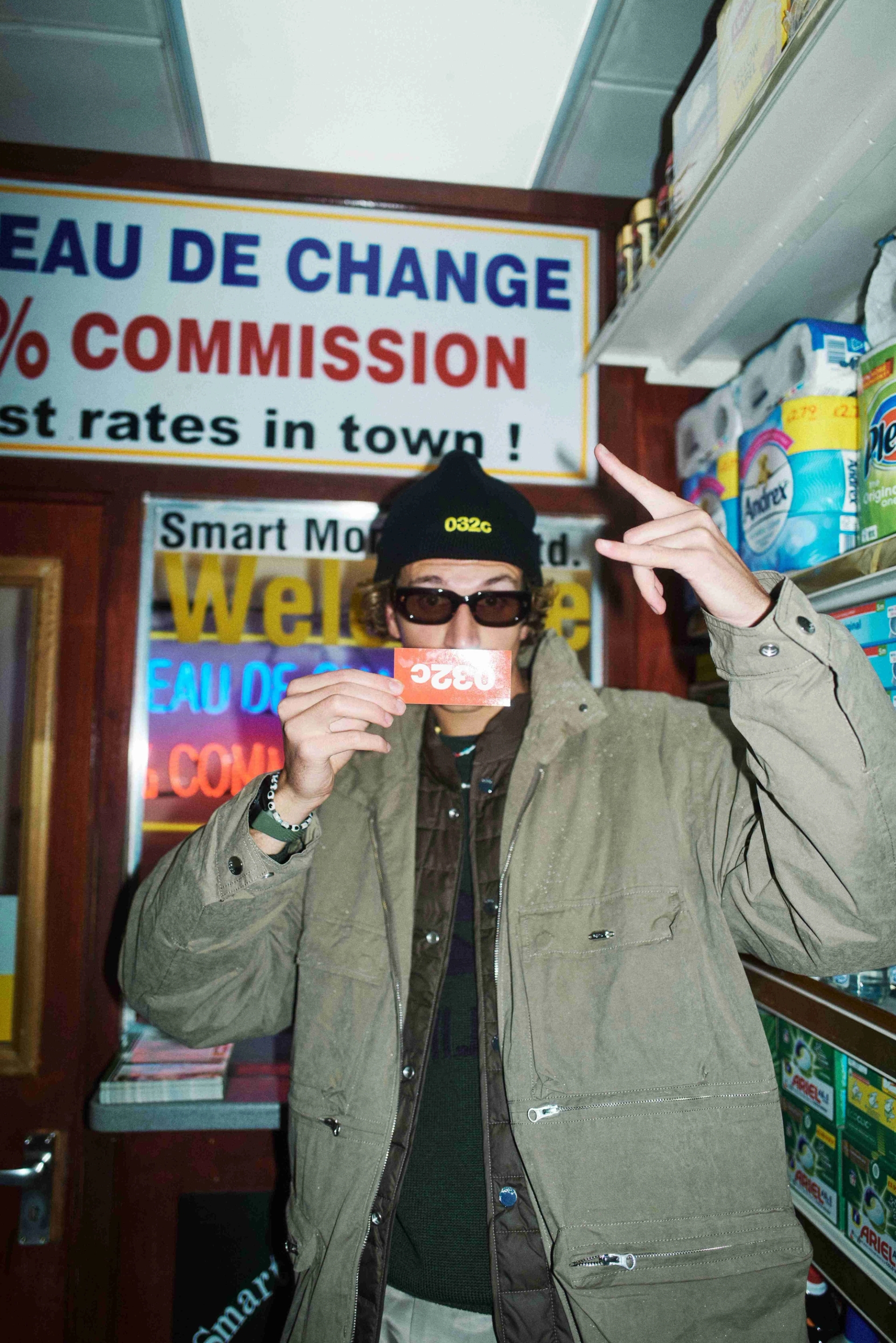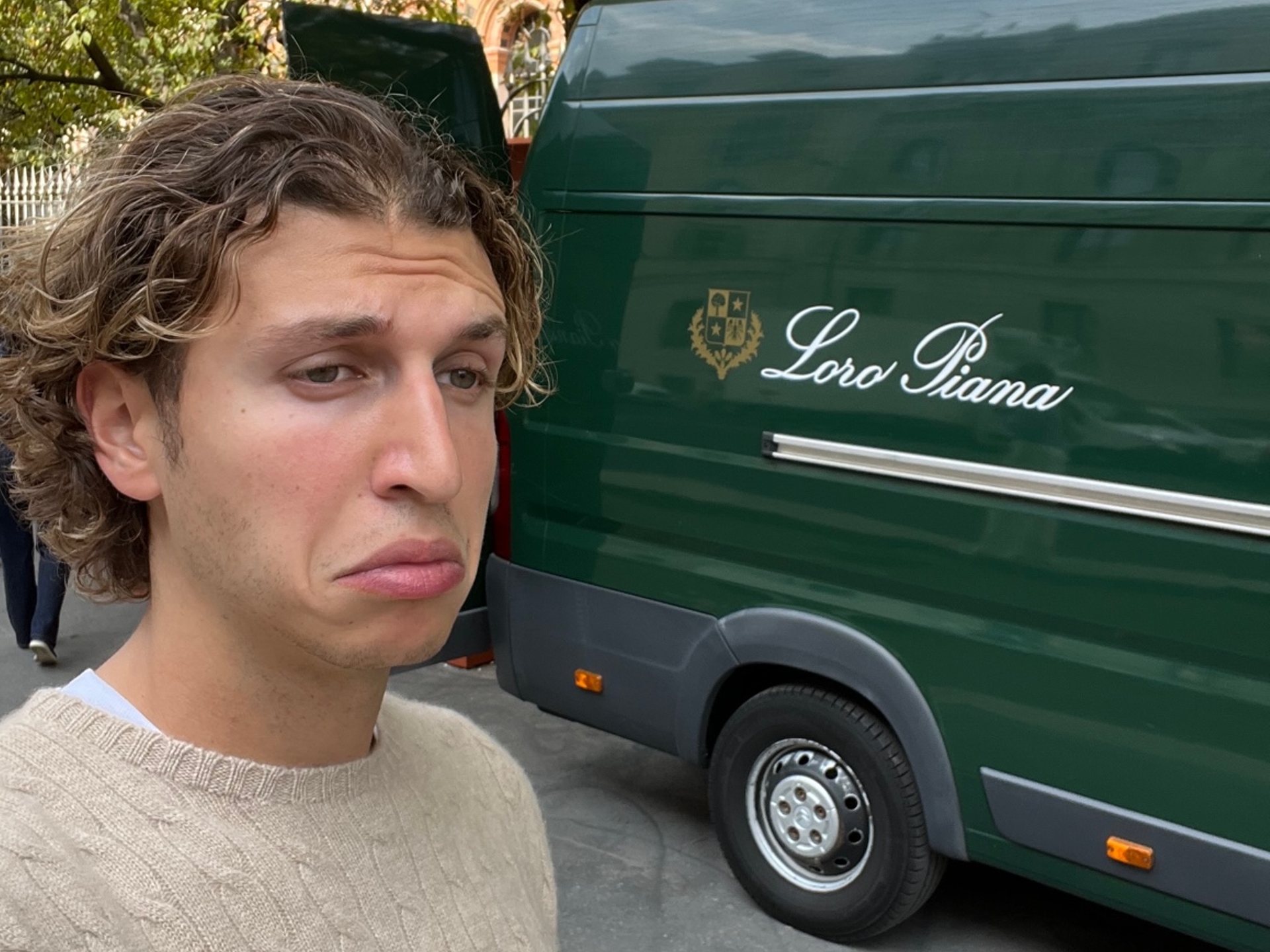Brenda’s Business with GSTAAD GUY
In the current age, 15 minutes of fame can be achieved with a video just 15 seconds in length. The ease in which content can be made, shared, and consumed means anyone can gain an audience with global reach overnight. Keeping said audience entertained for more than a few months before slipping back into irrelevance, however, is an alchemy of humor, luck, and personal branding. Four years ago, Gstaad Guy launched his career with a video he made of himself impersonating a friend originally intended as an inside joke for a group chat. The man behind it has since made a career out of two fictional characters, Constance and Colton.
They speak to different demographics of the same people, whom Gstaad Guy has given the dubious name of “The Unmarketable.” Constance is a bit of a snob, while Colton, is his hypebeast cousin. The two personas are both brand ambassadors in their own rights – Constance endorses exclusive, high-end luxury goods, while Colton acts as a flashier, logomaniac foil to his high-brow counterpart. Both, however, speak for those who typically dislike the feeling of being targeted: the ultra-wealthy. They do so while simultaneously marketing to those who enjoy lampooning the excesses of said ultra-wealthy.
Colton in 032c Field Jacket, 032c Fuzzy 'Selfie' Pullover, and 032c Beanie
Constance in his natural habitat
BRENDA WEISCHER: Can I tell you about a nightmare I had prior to this interview? I did a little too much research on you late at night. We conducted the interview, and you were in character the entire time. I couldn’t get you out of it, and it was so awkward. I’m glad to be speaking to the real you now — or at least I think I am.
GSTAAD GUY: I’ve never broken character online. If that were to ever happen, I would want it to be highly strategic.
BW: Online you’ve been in character for four years now. Looking back, is there a moment, such as a job offer or a fan encounter that made you realize that this could be a career?
GG: A month after I had filmed the first video, someone stopped me on the street. I was traveling at the time and had no social media account. A person said, “Oh, you're the guy from that video making fun of Gstaad. You're hilarious. My friends and I call you Gstaad Guy.” The fact that there was a month-long shelf life to a WhatsApp video was a big green flag. I know that because no one around me could name a single thing they had seen on their social media accounts that day. If I was to ask you right now to name three things you saw on your Instagram this morning, you would have a hard time telling me. And you’ve probably spent at least half an hour on Instagram or TikTok today
BW: Guilty as charged. I was browsing through your social environment on Instagram, and it seems like there are a lot of people with blue checks and millions of followers. In an era where anyone can be famous and have a platform, what is the value of a “quality” following? It’s not really about numbers anymore. I’m assuming you don’t get a TagHeuer deal with millions of followers, you get it with millionaire followers.
GG: Yeah, it's like the party logic. A party is good not because of how many people are there. A party is cool because of who’s there, and most of all, if people are having fun, and people are laughing. Brands are looking for those cool parties; they're looking for niches. Yes, my account grew to have a blue tick and has become more far reaching, but I’m still giving my audience the content they signed up for 4 years ago when I had under a thousand followers. I think a lot of creators become confused when they grow, about what it means to have followers and what they should give to them. If you follow someone because they are a chef, you want to see the food they make. You don't want to see them brush their teeth or go to the gym. Many creators end up diluting their niche with junk that no one cares about. No one cares that you're tanned and on the beach. No one cares about you and your friends at dinner. Save that for your finsta, your close friends, or send it to your family group chat.
Colton in 032c Field Jacket, 032c Fuzzy 'Selfie' Pullover, and 032c Beanie reading 032c Issue #42
BW: It's interesting to touch on that as your account is growing. How do you keep the value of an inside joke, without excluding everyone who is new?
GG: I think that people typically follow me because they either relate to Colton and dislike Constance or relate to Constance and dislike Colton. If you can’t relate to one, you can relate to the other. Or at least one of the characters reminds you of a close friend or family member. Or even an ex. But there's a sense of pleasure in not belonging to either side, and trying to dig, intrigued to see a world you maybe don't know much about. I use comedy to highlight some of the absurdities of that world. I try to make sure that I keep the absurdities as something to laugh with though and ideally not aspire to.
BW: That’s important to highlight — Gstaad Guy is not a motivational account.
GG: In some elements, it actually has become one. Constance teaches valuable lessons about treating people with respect, not feeling insecure about missing out, prioritizing quality over quantity, and more. Although he is fictional, he is wise and he does have great taste. I’m very happy with all those teachings actually being motivational. I think the lens of comedy and absurdity helps these messages reach a wider audience. I just never want my page to create insecurities with people who don't have the financial means to access the same material possessions that the characters do. I’d rather they just laugh at those things. Because they really are absurd. When Constance is being a total snob, I hope it creates a sense of insecurity with the people who have the means and opportunity to do good with their time and resources and choose not to. Of course, the main ambition of the comedy is that it's fun, but I hope that it occasionally flicks a “wait do I really sound like that” switch in some people's minds.
BW: Let’s talk business. How do you work with brands? How do these collaborations happen?
Colton in 032c Field Jacket, 032c Fuzzy 'Selfie' Pullover, and 032c Beanie
GG: Most of the brands I've worked with have been extremely organic partnerships. I don’t work with brands that either I or my characters do not have a genuine love or affiliation to in real life. My characters are fictional, but they are ambassadors of archetypes in the real world. The things they like are things these people actually like, or that I genuinely like, for example, Loro Piana. I genuinely love the brand. I think that it is the most luxurious brand on the face of the earth, however, when I first started the page I realized that some people love it for different reasons. They love it for the status that comes with an understated overstatement. There's some comedy there. It's hilarious, “Look at how understated I am.” Do you realize how oxymoronic that is? I had to make some videos about it, and naturally we ended up working together.
BW: I don't think such a collaboration is “natural” for a brand like LP. Usually, they don’t work with anyone. They hardly advertise. But now with a comedian? Before they started working with you, they had no way of talking to the sons and daughters of their customers. It's quite surprising that a rather conservative brand is doing this.
GG: I agree. It landed on their lap as I was organically pushing their products. When I walked into the London store once years ago, shortly after I started the page, a sales rep told me, “We can't believe you're here. We've had 20 kids rush through the door today and tell us they want exactly what you're wearing.”So I would give this advice to any content creator out there. If your dream is to work with X Brand, talk about it and push it organically. The brand will notice, and their marketing teams will always prefer to pick a person with a genuine love for the products, over someone they have to pay to talk about them for the first time.
Colton in 032c Field Jacket, 032c Fuzzy 'Selfie' Pullover, and 032c Beanie at Loro Piana
BW: They would have missed out on their behalf if they didn't contact you. However, it’s also a bit risky to work with someone who makes jokes at their customers` expense.
GG: I do see how it can seem that way, but none of the customers I’ve spoken to think that. When the dial of absurdity is turned up, nobody feels targeted or being made fun of. On the contrary, they feel praised and flattered - because although it is comedic, Constance approves of them. I've never actually had anyone take real offense. For example, I made a video about charity events once, and the charities weren't offended. The organizers know that the events are ridiculous. The charities know that the people who are there donating spent more on the diamonds and dresses they were wearing on that day than they did on donations. They know the system is weird, and the partakers also know, “Hey, we're sitting in a circle flexing how much we can donate.” Even when it comes to philanthropy, there’s showing off involved. They know it’s true deep down. I’m just shining some light on it.
BW: Can the brands take a joke? How much creative freedom do you get with your partnerships?
GG: Yes, and I think it is partially due to who my audience is. The brands know that I effectively market to the unmarketable. The ultrahigh-spending community are by far the hardest people to convert to customers. For teeth whitening products and weight-loss teas I’m the wrong guy, but if you want to target an audience for an ultra-luxurious product or service, I’m your guy. But I’m extremely picky with who I choose to work with.
BW: Tell me who is making more money, Constance or Colton? Are they competitors?
GG: I’d rather not talk about the comp. But the higher demand is definitely Constance. The things he doesn't dislike, he adores, and he can count them on his right hand. He is a man of tradition, a man of habit. To like a new thing happens in decades, not in months. So when Constance approves of something, it carries a lot of weight. Colton is on the other side of the spectrum. He's a happy-go-lucky guy. He loves new things, and he loves change. And people expect him to jump on the bandwagon of what’s cool and trendy. People care about what Colton likes and cares about, but Constance is on another level.
BW: I want to talk about the advantage of having a fictional character. I feel like you can’t burn relationships as the “real you.“ Instead you can let Constance and Colton walk the fine line of sarcasm. You can do jobs that would ruin other creators. That’s your segue into Colton walking the Philipp Plein show. You have made fun of the brand for years, or rather their customers. How did that happen?
GG: It sounds strange but I have built friendships by making fun of people and brands. Constance hates Alec Monopoly’s art, for example, and he speaks about it outwardly on the page. And who laughed at the very heart of those jokes? Alec. We connected and became friends. Last year, Colton worked with Virgil (Abloh) for the Off-White show in Paris. Virgil has been one of my earliest supporters. It was amazing. And he always pushed me to go bigger and crazier with my content. But where do I go from here? I had to do something even more absurd, and it just so happened that Philipp Plein is one of those people who can take a joke too. So Colton walked his fashion show in Milan. It was overstated in every way, which is exactly what Colton is. Colton screams, and Constance whispers. It was perfect.
Colton walking for Philipp Plein
BW: How are you able to keep the joke going? Is this something that worries you four years in? How do you ensure longevity? You're not planning to add another character, right?
GG: Not really, I don’t fear longevity or the lack of it. As long as there are more people coming in through the door than people going out, that's growth. I’m continuing to elevate the storytelling, the brand, and the identities of the characters. And lots of my followers feel like they know my characters personally and that they’re growing with them as time progresses, so I have no reason to believe that that should change any time soon. But who knows, I’m just going day by day and hoping for the best.
BW: What I’ve noticed from watching your content since 2019 is familiarity. While you always insert new jokes, there’s a lot of repetition.
GG: The content has changed massively, for the better in my opinion, but I like to keep a few consistencies. One of them is my “it's all family” hashtag. In my very first video I say, “Gstaad, it’s all family.” The families, the hotels, the waiters — it’s such a tiny community. They all know each other. If you forget your credit card, you put something on the family tab. It’s a theme I kept over the four years, and I like the meaning. Because Constance, The Gstaad Guy, is all about family - just like Gstaad. It’s one of the core values of the page. Some other taglines are more playful and just fun like “Hop.” And the other taglines like “dip” and “fantastique” I only started about a year ago, but they’ve really created a strong sense of community outside my page. It’s something people say to each other in real life too, such as “Constance would never approve of that flashy outfit — à la poubelle.”
Constance, who prefers quality over quantity
BW: Talking about real life, the amount of merchandise on your website is endless. How does merch work? Do you make money out of it, or does it exist purely to connect with your audience?
GG: Some of my audience is priced-out of the products and experiences that I talk about on my page, and I didn’t really like that. So I thought that merch would be a great way to allow people to be a part of the community without being priced-out. I actually make a loss on a lot of the products. So it’s not really there for the financial upside: it's more a way to allow more walks of people to participate in the conversation and the Gstaad Guy world. If you have the means to engage with the high-end things I talk about, you’re free to do so, but I don’t want everyone else to feel excluded. I'm making fun of the gatekeepers, right? I make fun of the members' clubs, but I don't want to be a member's club. Onto how merch works for me, there’s this beautiful thing called POD: Production on demand.
BW: That sounds sexy.
Colton in 032c Field Jacket, 032c Fuzzy 'Selfie' Pullover, and 032c Beanie
GG: Very. POD effectively means that my items are only produced once a customer places an order. So you see my sweatshirt on my website? The sweatshirt does not actually exist in real life. It is a fictional design. If you place an order, the design is printed on a plain sweatshirt. It's packaged in custom-made packaging that's also printed on the spot. It seems tailored — as if I have a factory and an operations team. But I don’t. Yes, my margins are less attractive than they would be if I had an inventory. But the zero risk, and zero upfront costs, and zero wasted material through inventory that doesn’t sell definitely make up for it.
BW: As your community grows, considering the nature of your jokes, does it scare you to say the wrong thing?
GG: I definitely sense more responsibility. Although not saying the wrong thing just takes a little bit of awareness. Just be conscious about the repercussions of your words. A lot of people with a platform think, “I can say whatever I want because this is who I am.” But actually, you can't. If you have a public profile and you have people who can be influenced by what you're saying, you have a duty to say the right thing. Or at least to not say the wrong thing.
I felt the consequences once when I launched my song “Commercial Flight (Hop Hop Hop)” three years ago. There’s a short conversation mid-song where I talk about Juuls, those little vapes —genuinely a thing I hate. It’s fine if you’re quitting smoking, but if you've never smoked before, what are you doing? Anyways, Constance’s butler Alfrèd makes a joke along the lines of, “Juul? It better be cucumber flavor.” We didn’t think much of it because it’s a minuscule part of the song. One year later, 50 students at Charterhouse — one of the most prestigious boarding schools in the UK — performed “Commercial Flight” live in front of the entire school with a choir. I went to surprise them, and it was amazing. After the performance I go to meet the kids, and one of them waved his Juul at me saying, “Don't worry, it's cucumber!” I was like, “What?” I went back home, watched the video over, and realized I had completely forgotten about it. I really hope that my video didn’t accidentally turn a 14 year old into a vape smoker. That definitely created another layer of awareness.
BW: A lot of young people will read this and be ready to quit it all to follow in your footsteps. As we’re talking about responsibility, can you tell me about feeling confident enough to do this full-time?
GG: I worked a full-time corporate job at Apple for two years. After that, I got a job at Coinbase and worked there for a few months before taking the leap. When I took the leap with Gstaad Guy, I had already forged brand deals with 15 companies and had views in the millions. That’s my advice for any person daring to risk it. Keep your job. Stay up late. Work during lunch breaks. Hedge your risk, and try to juggle it all until you’re in a position of strength. And if you think you can’t find the time or energy, you can. There are so many resources out there to save you time and make things happen quickly. Film on a Saturday, edit on a Sunday. Learn from other creators. Film seven clips in one day, so you can post one every day of the week. You can always do more. Don’t get too confident and quit prematurely. Think of Vine, for example. These people were making hundreds of thousands and even millions monthly when it was relevant, but now they're almost all done. Think about Instagram’s early blogger era, how many of them are still on top? I already see it happening to TikTokers.
Colton in 032c Field Jacket, 032c Fuzzy 'Selfie' Pullover, and 032c Beanie at Loro Piana
BW: Keeping an audience engaged and loyal over years is a science only very few have mastered.
GG: It's a marathon, not a sprint. Staying at the top of relevance, reinventing yourself, reinventing your brand, reinventing your business, and converting people into customers over and over and over again for years, that’s the goal. But it's nearly impossible to do. I have nothing but respect for people who have successfully managed to do so, without negatively affecting their personal lives of course. Having followers has always just been a gear in my engine. It’s never been the award. It’s important to know for your emotional stability, love life, social life, and personal health that it’s just a part of your business, and not something that defines who you are.
BW: Absolutely. What’s going to happen in terms of the character development of Constance and Colton?
GG: I think the characters are douchebags in their own ways, but they've come a long way. Constance is still a big snob, but he's become a bit friendlier and wiser. He has a bit of a smile sometimes. His chin is slightly less high, and he’s been more open-minded. Colton’s attitude has rubbed off on him. Colton was the ignorant douche of the douchebags, but he’s becoming slightly more sophisticated. He's becoming a little more cultured, and his clothes are slightly less ugly. They’re both growing, hopefully like the rest of us are.
BW: Ten years from now, they might meet somewhere in the middle.
GG: Maybe not in how they dress, but in their values, I hope so. I’m confident that one day they will both be perceived as good and pleasant people, and I hope that my viewers can be part of that journey.




